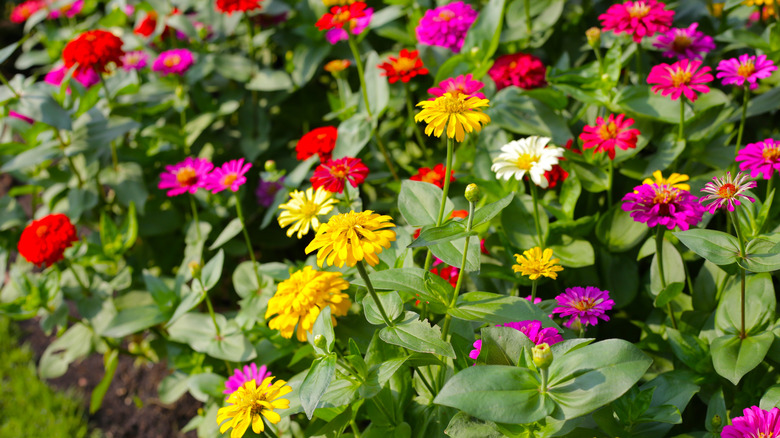The Only Lavender Varieties That Actually Grow Well Next To Zinnias
If you're a cottage garden enthusiast or you just love pairing different flowers to create a gorgeous floral display, you might think that zinnias and lavender would look fantastic together, and they would. But there's one fundamental problem with this pairing: These two species don't enjoy the same growing conditions, unlike plenty of other herbs and flowers you should be growing near zinnias in the garden. While lavender thrives in sandy or rocky soil that's on the dry side, zinnias are happiest in moist loamy soil. So growing these two together means that one or the other will not grow all that well. However, if you really want to try and create this amazing aesthetic, the only lavender varieties that may actually grow well next to zinnias are Lavandula x intermedia 'Phenomenal', or Lavandula angustifolia 'Havana'.
'Phenomenal' is one of the hardiest lavender varieties as it can tolerate more heat and humidity than other species. You'll often find that humidity is the silent killer of lavender species that are commonly grown. It's also resistant to root rot diseases that will spell the demise of other varieties when grown in the types of soil conditions that zinnias prefer, though it's still more likely to thrive in a drier environment. This lovely perennial with soft silvery foliage and impressive spikes of rich purple flowers is hardy in USDA zones 4 through 9, indicating that it's relatively cold-hardy as well.
'Havana' lavender and look-alikes to consider
'Havana' can tolerate slightly more moisture in the soil than many other lavender varieties. As this is an English lavender hybrid, it will grow as a perennial in zones 5 through 9. It has charming silvery green foliage and stunning deep purple blooms that can be bicolor. It also survives winter better than other cultivars or species.
For a similar aesthetic with plants that will happily grow beside those dazzling zinnias in your garden, you might like to consider sea lavender (Limonium sinuatum) or catmint (Nepeta spp.). Both of these plants have beautiful purple blooms that will complement the brilliant floral colors of your zinnias. Sea lavender is a form of statice with eye-catching purple and white papery blooms, while catmint has tall spikes with masses of small blue, purple, or white flowers. However, you should note that Nepeta cataria is considered invasive in the states of West Virginia and Kentucky. If you live in these states, you might want to consider the Nepeta x faassenii species commonly known as blue catmint, which is not on any invasive plant lists. It has pretty lavender blue flowers that are beautifully fragranced. Or, why not think about planting an easy-to-grow annual that protects zinnias from pesky garden pests, borage, for a burst of a similar color?

